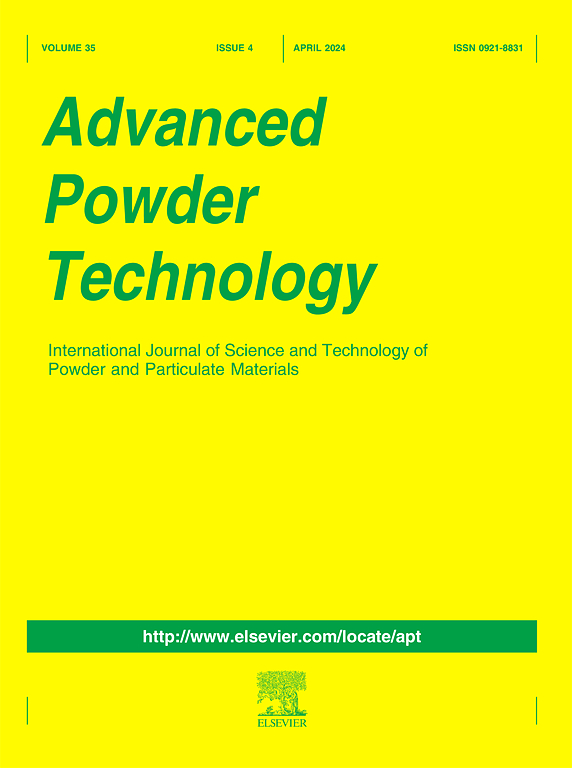Hierarchical model acquisition and parameter calibration of the corncob based on the discrete element method
IF 4.2
2区 工程技术
Q2 ENGINEERING, CHEMICAL
引用次数: 0
Abstract
To establish the optimal model and bonding parameters that align with the structural features of corncobs during harvest, a breakable discrete element model was developed, reflecting its two-layer structural composition (core marrow and xylem annulus) through a hierarchical modeling approach. Compression and bending tests were conducted to quantify the biomechanical parameters of each corncob component, which were subsequently utilized for model parameter calibration. The bonding parameters among core marrow-core marrow, xylem annulus-xylem annulus, and core marrow-xylem annulus were calibrated based on the results from compression tests, employing the Plackett-Burman, steepest ascent, and Box-Behnken calibration methodologies. Ultimately, the bending destructive force of the entire corncob and its mechanical bending properties served as evaluation metrics to thoroughly validate the overall characteristic parameters of the corncob. Furthermore, by analyzing the morphological alterations of the corncob during both actual and simulated compression and bending, the findings indicate that the hierarchical DEM model developed in this study, along with the calibrated bonding parameters, demonstrates high accuracy in simulating the crushing behavior of real corncobs. The hierarchical bonded particle model presented herein lays the groundwork for future research aimed at constructing a high-fidelity corn ear model capable of characterizing kernel separation and the breakability of corncobs.

基于离散元法的玉米芯分层模型获取与参数标定
为了建立与收获期玉米芯结构特征相匹配的最优模型和键合参数,通过分层建模方法建立了反映玉米芯两层结构组成(核心髓和木质部环)的可破碎离散元模型。通过压缩和弯曲试验来量化每个玉米芯部件的生物力学参数,随后利用这些参数进行模型参数校准。根据压缩试验结果,采用Plackett-Burman、最陡坡和Box-Behnken校准方法,对核心髓-核心髓、木质部环-木质部环和核心髓-木质部环之间的键合参数进行校准。最终以整个玉米芯的弯曲破坏力及其力学弯曲性能作为评价指标,彻底验证玉米芯的整体特性参数。此外,通过分析玉米芯在实际和模拟压缩和弯曲过程中的形态变化,研究结果表明,本研究建立的分层DEM模型以及校准的粘合参数在模拟真实玉米芯的破碎行为方面具有较高的准确性。本文提出的分层键合粒子模型为今后构建能够表征籽粒分离和玉米芯易碎性的高保真玉米穗模型奠定了基础。
本文章由计算机程序翻译,如有差异,请以英文原文为准。
求助全文
约1分钟内获得全文
求助全文
来源期刊

Advanced Powder Technology
工程技术-工程:化工
CiteScore
9.50
自引率
7.70%
发文量
424
审稿时长
55 days
期刊介绍:
The aim of Advanced Powder Technology is to meet the demand for an international journal that integrates all aspects of science and technology research on powder and particulate materials. The journal fulfills this purpose by publishing original research papers, rapid communications, reviews, and translated articles by prominent researchers worldwide.
The editorial work of Advanced Powder Technology, which was founded as the International Journal of the Society of Powder Technology, Japan, is now shared by distinguished board members, who operate in a unique framework designed to respond to the increasing global demand for articles on not only powder and particles, but also on various materials produced from them.
Advanced Powder Technology covers various areas, but a discussion of powder and particles is required in articles. Topics include: Production of powder and particulate materials in gases and liquids(nanoparticles, fine ceramics, pharmaceuticals, novel functional materials, etc.); Aerosol and colloidal processing; Powder and particle characterization; Dynamics and phenomena; Calculation and simulation (CFD, DEM, Monte Carlo method, population balance, etc.); Measurement and control of powder processes; Particle modification; Comminution; Powder handling and operations (storage, transport, granulation, separation, fluidization, etc.)
 求助内容:
求助内容: 应助结果提醒方式:
应助结果提醒方式:


